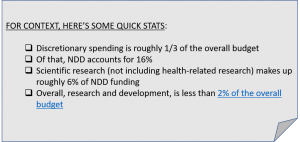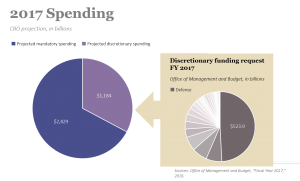April 11, 2017
Federal Budget: Clarity on Parity
Posted by Timia Crisp
Congress has much to do in the way of appropriations this year. While Congress works to prevent a government shutdown on 28 April, when funding for Fiscal Year (FY) 2017 runs out, the budget and appropriations process for FY2018 has already begun. The President’s FY2018 “skinny” budget was released on 16 March. The budget, which outlines the President’s priorities, proposes a $54 billion increase in defense spending by decreasing non-defense discretionary spending (also known as NDD). But what does that mean? More specifically, what does that mean for science?
First, let’s breakdown the budget. The overall budget is divided into two categories: mandatory and discretionary spending. Mandatory spending (also called entitlement spending) is considered automatic since it is not determined by annual appropriations bills. Mandatory spending, which accounts for roughly two thirds of federal spending (Fig. 1), includes programs like Social Security, Medicare, and Medicaid.
Discretionary spending is the other roughly one third of federal spending and is further divided into defense discretionary spending and non-defense discretionary (NDD) spending (Fig. 1). Defense discretionary spending is just that – the portion of the federal budget that includes the Pentagon and related military spending. A little more ambiguous is NDD spending, which is jargon for “everything else”, including science. So, when the President proposes to increase defense spending by cutting NDD spending across the board, they are talking about cuts to programs including water monitoring, food safety, public transit, education, and scientific research.
 AGU continues to maintain that defense spending should not increase at the expense of NDD spending. Rather, we should keep parity between NDD and defense spending—meaning an increase in defense should also mean an increase in NDD as well.
AGU continues to maintain that defense spending should not increase at the expense of NDD spending. Rather, we should keep parity between NDD and defense spending—meaning an increase in defense should also mean an increase in NDD as well.
Wondering what you can do to help us spread this message? We need you to amplify our voice by telling your legislators to keep parity between NDD and defense spending.
Remember, the President’s budget is not the end all be all. Congress has the final say, so contact your legislators today! For more information about the federal spending process and more ways for you to engage, watch our webinar.


